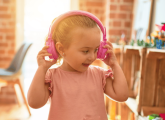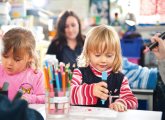Phonics continues to be a key strategy to teaching reading but did you know that phonics is based completely on a child’s ability to process speech sound information?
The underlying skill for phonics is phonological awareness. This is the ability to play with sounds within words – take them away, add them in, substitute them – all to make new and different words.
For phonological awareness to develop effectively, it needs to be a speech only skill. It’s not about seeing visual patterns and seeing the letter shapes, it’s about being able to hear and manipulate the sounds themselves.
Phonological awareness starts developing with an understanding of rhythm and is why singing, dancing, nursery rhymes and playing with simple percussion is so crucial for toddlers.
From that, children learn to hear the “chunks” of words (the syllables) and from there breaking those words into still smaller parts; the first sound of the word and the rhyme at the end.
Until those skills have been mastered and a child has this level of phonological awareness, they can’t start to break down and blend and manipulate individual sound units. There’s no shortcut to phonological awareness and without it, phonics cannot be an effective decoding strategy.
So how in Early Years can you support the development of phonological awareness?
First step is syllable patterns – can the children clap along to the syllable pattern of their name?
Can they march along with the syllables in words in sentences?
Can they move with the syllable pattern of words – Brown Bear Brown Bear has some lovely opportunities for timing gestures with syllable patterns and there are many other books with repetitive phrasing that allow for clapping/gestures /stomping along to the syllable patterns.
Once a child can recognise syllable patterns, we can help them to identify “how many claps” are in a word.
You can play a sorting game with a pile of pictures, each child claps out the syllables and places the picture on the corresponding number – helicopter would be four claps and would go on the number four, crocodile would be three claps and would go on the number three and so on.
One game I enjoy playing is a take on “what’s the time Mr Wolf”. The children turn over a picture, identify the number of syllables by clapping it out and then they shout the word out loudly taking steps forward along with the syllable pattern! Who can get to Mr Wolf first!
Once the children are demonstrating awareness and identification you can move onto the next steps in phonological awareness – rhyming and identifying the first sound.
Again, it’s important to avoid using written words – pictures and spoken words only. You can play “snap” with pictures of words that rhyme so they “snap” when they find a rhyme rather than the same picture.
You can go on rhyming walks – each child has a picture (something with lots of possibilities for rhyming) and they have to explore and find three things that rhyme. For example – a child could take a picture of a tree and they could find a knee, the sea and a bee!
I-spy is a great game for spotting what words begin with but another one I enjoy is making first sound feely bags! You can fill a bag with objects starting with a sound and see if the children can identify the objects in the bag by touch alone and then work out what sound they all start with.
Once they’ve got the hang of it, see if they can create their own feely bags for their friends.
If you can work through these steps with your Early Years children, you can be confident you are giving them the best chance to get ahead in phonics.
BLAST is Boosting Language Auditory Skills and Talking. Everything you need to deliver BLAST is in the box – all of the planning, the resources and the photocopiable materials. All you need is a group of children, a CD player (for BLAST 1) and a trained BLAST leader.
For more information visit blastprogramme.co.uk.

Audio resources – How to use them in Early Years
Editors picks

EYFS writing – Help children develop physical skills
Editors picks
